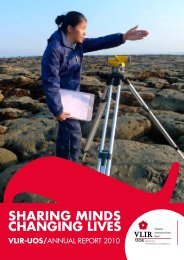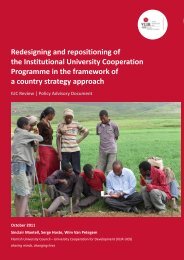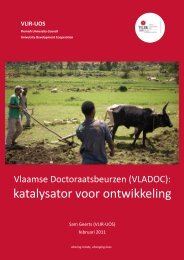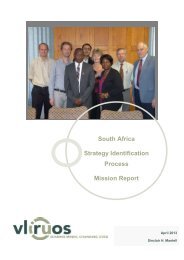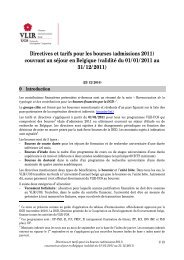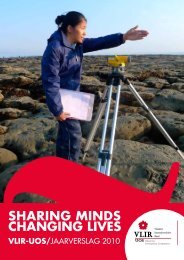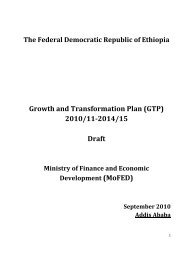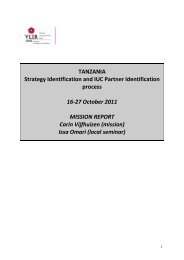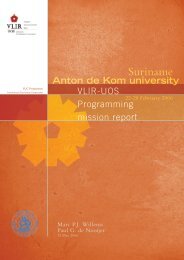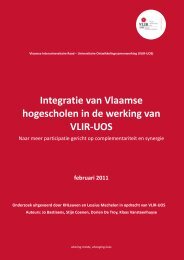Education Sector Development Program - VLIR-UOS
Education Sector Development Program - VLIR-UOS
Education Sector Development Program - VLIR-UOS
Create successful ePaper yourself
Turn your PDF publications into a flip-book with our unique Google optimized e-Paper software.
—<br />
CHAPTER<br />
3<br />
Priority action programs<br />
The economic and social development of<br />
Ethiopia’s population demands profound<br />
improvements in the education sector. ESDP IV<br />
focuses on priority programs which help realize<br />
these improvements. These respond to the key<br />
challenges described above. However, these<br />
programs are not organized in the same manner:<br />
they are organized partly by sub-sector (general<br />
education, TVET and higher education) and partly<br />
by priority themes (quality, equity and improved<br />
management). Specific programs are developed<br />
for crosscutting issues, which are not linked to<br />
any specific sub-sector but concern the system<br />
as a whole. All of the key challenges analyzed<br />
in chapter 2, are therefore addressed through<br />
interventions in several programs.<br />
The structure of the priority action programs is<br />
as follows:<br />
1. Within general education<br />
❚<br />
❚<br />
❚<br />
❚<br />
❚<br />
Improving quality (with a first subprogram<br />
for early childhood care and<br />
education (ECCE) and a second subprogram<br />
for primary and secondary<br />
education. Both rely on a similar set of<br />
strategies for quality enhancement)<br />
Increasing equity and access (with<br />
three sub-programs: early childhood<br />
care and education, primary and<br />
secondary education<br />
Expanding adult education with<br />
specific attention to Functional Adult<br />
Literacy/FAL)<br />
Special support program for the<br />
emerging regions<br />
School Water, Sanitation and Hygiene<br />
(WASH)<br />
❚ Community Participation<br />
2. Strengthening Sciences and Technology<br />
3. Developing Higher <strong>Education</strong><br />
4. Cross-cutting programs<br />
❚ Capacity development for improved<br />
management<br />
❚<br />
❚<br />
❚<br />
❚<br />
❚<br />
❚<br />
Gender and education<br />
Special needs education/Inclusive<br />
education<br />
HIV/AIDS and education<br />
Environmental education and<br />
protection<br />
<strong>Education</strong> in emergencies<br />
School health and nutrition<br />
❚ Drug and substance abuse prevention<br />
in education<br />
Each program is presented hereafter in four<br />
sections. Firstly, a situation analysis summarizes<br />
progress made during ESDP III and concludes<br />
with main challenges. Secondly, the main<br />
expected outcomes and key indicators are<br />
identified. Thirdly, a brief analysis is presented on<br />
the main strategies which will be implemented<br />
to achieve these outcomes. Fourthly, a program<br />
matrix organizes the strategies and component<br />
activities.<br />
Notes/reminders on indicators and targets:<br />
All of the matrices contain indicators and/<br />
or targets. These are helpful to monitor the<br />
progress made with the achievement of the<br />
expected outcomes and the implementation<br />
of the proposed programs and activities.<br />
Targets have been formulated where<br />
baseline data are available and/or where<br />
the final objective is clear. In several<br />
cases, no baseline data are at the moment<br />
available and it is very difficult to formulate<br />
a target at this stage. In this case, only the<br />
relevant indicator is mentioned. For some<br />
indicators, information is already being<br />
collected by various departments as part<br />
of their normal administrative and reporting<br />
procedures but this information is not analyzed<br />
at present and no indicators are available. In other<br />
cases, the information is not yet being collected.<br />
It is suggested that, during the implementation<br />
of ESDP IV, the already available data will be<br />
analyzed and, where necessary, additional data<br />
will be collected; this can then form the basis to<br />
define a target.<br />
The priorities for<br />
general education under<br />
ESDP IV relate to two<br />
major objectives: to<br />
improve the quality of<br />
general education and<br />
to increase access and<br />
equity<br />
15



